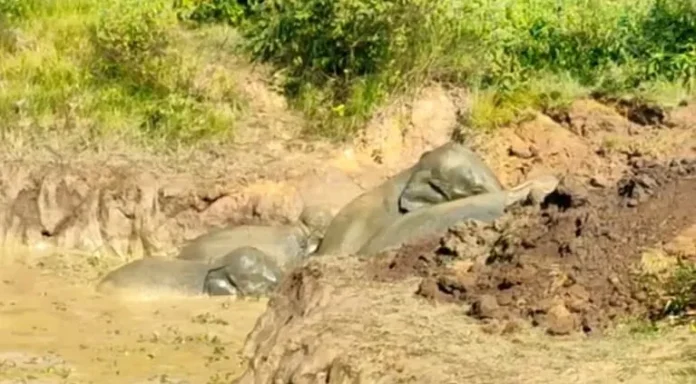Six wild elephants were freed after being trapped in a pit at a brick factory near the Gibbon Wildlife Sanctuary in Assam. The incident, which sparked widespread concern, saw a coordinated effort between forest officials, wildlife rescue teams, and local authorities. The rescue not only highlights the ongoing challenges of human-wildlife conflict in the region but also underscores the resilience of conservation efforts in Assam’s protected areas.
The Incident at Gibbon Wildlife Sanctuary
The six elephants, part of a larger herd, were reportedly wandering near the Gibbon Wildlife Sanctuary, which is renowned for its biodiversity and the famous hoolock gibbons. The elephants, likely foraging for food or exploring their territory, stumbled upon an open pit used by a local brick factory. The pit, which was not adequately secured, posed a grave danger to the elephants, especially given the soft, muddy nature of the ground.
As the elephants ventured too close to the pit, the ground gave way under their weight, and they fell into the large, deep hole. The trapped elephants, including both adults and calves, struggled to escape, but their efforts were in vain. This distressing sight prompted immediate action from locals, who alerted the authorities.
The Coordination of the Rescue Operation
News of the elephants’ plight quickly reached the forest department and the Assam State Zoo authorities. A team of wildlife rescuers, including veterinarians, forest rangers, and volunteers, was dispatched to the site. The rescue operation was complex, as the pit was deep, and the elephants were at risk of injury due to the intense struggle.
The rescue teams, familiar with the unique challenges of freeing large animals in such situations, carefully planned their approach. Using excavators, ropes, and cranes, they began the painstaking task of creating a safe path for the elephants to climb out of the pit. Veterinarians administered tranquilizers to calm the elephants and minimize the risk of injury during the operation.
A Delicate and Challenging Operation
The operation was fraught with challenges. The elephants, already stressed from being trapped, posed a risk to the rescuers due to their size and strength. Moreover, the deep pit made it difficult for the elephants to regain their footing without assistance.
The rescuers, however, worked meticulously and carefully. After several hours of strenuous efforts, the first elephant was successfully freed, followed by the others. Each elephant was monitored for injuries, and the team ensured that they were able to stand and walk without distress. In total, the rescue took over eight hours, with the final elephant being freed as night fell.
The freed elephants, though exhausted, were observed returning to the nearby forest, where they blended back into their herd.
The Human-Wildlife Conflict
While the successful rescue operation brought relief to conservationists and animal lovers, it also highlighted the ongoing issue of human-wildlife conflict in Assam. The state, home to a significant population of wild elephants, has seen a rising number of incidents where elephants are involved in conflicts with human settlements, often leading to casualties on both sides.
The increasing encroachment of human activity into wildlife habitats, especially in areas like the Gibbon Wildlife Sanctuary, has created a dangerous overlap between elephant corridors and industrial operations like brick factories. The presence of unprotected pits, poorly constructed roads, and other hazards in these areas can lead to such accidents.
Assam has also witnessed increasing incidents of elephant herds wandering into agricultural fields, often leading to crop damage and confrontations with local farmers. In response, the state has been working to implement measures to mitigate these conflicts, including creating wildlife corridors, enhancing safety in areas with high elephant populations, and promoting better coexistence strategies between humans and wildlife.
A Call for Improved Wildlife Protection
The rescue operation has also underscored the need for greater vigilance and better planning in areas where elephants are known to roam. Conservationists are calling for better infrastructure and monitoring systems to prevent such incidents.
Experts suggest that there needs to be increased awareness about the safe management of factory sites and other areas that might pose a threat to wildlife. The pit at the brick factory, for example, could have been covered or secured to prevent such a tragedy.
The Gibbon Wildlife Sanctuary, while home to diverse wildlife, has faced significant pressure from development projects in recent years. The sanctuary, known for its rare hoolock gibbons and other endangered species, has become a focal point for the conservation community, which urges authorities to focus on protecting the sanctuary’s delicate ecosystem.
Conclusion
The rescue of the six elephants in Assam serves as both a relief and a wake-up call. It highlights the success of coordinated rescue efforts but also reminds us of the pressing need to balance development with wildlife conservation. As human encroachment continues to threaten wildlife habitats, it is crucial to focus on measures that protect both animals and people.
The elephants’ rescue not only saved lives but also brought attention to the larger conversation about sustainable living and the preservation of India’s rich natural heritage. As Assam continues to grapple with human-wildlife conflict, this incident serves as a reminder of the importance of proactive conservation and responsible development.




